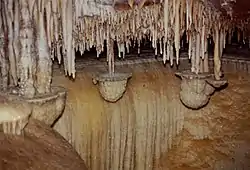Quri Qala Cave
Quri Qala Cave or QuraQala (Kurdish: Şkefta QureQela, ئەشکەوتی قوڕەقەڵا Persian: غار قوری قلعه) is a cave located northwest of Ravansar, Iran, and is one of the longest caves in western Asia. First explored in the 1950s, in 1989 it was further opened by an Iranian team. It contains three main chambers, with calcite crystals, stalactites and waterfalls. It is known for its colony of Mouse-eared bat, and for a number of archaeological finds, including silver vessels dating to the late Sassanian period.


References
- Caves of Iran, Quri Qale Cave
- Akbarzadeh, D., T. Daryaee, and J. A. Lerner, 2001, Two Recently Discovered Inscribed Sasanian Silver Bowls, Bulletin of the Asia Institute, vol. 15, pp. 71–76
- Alibaigi, S., Moradi Bisotuni, A., Rahimi, F., Khosravi, Sh., Alibaigi H (2017) The Late Sasanian Treasury of Qouri Qaleh Cave: Votive Offerings for a Mithra Temple in Kermanshah, Western Iran. Iran, 55 (2): 227–252.
- Rahimi, F., 2004 Technical Examination and Provenance Studies on Sasanian Silver Vessels from Quri Qaleh, In T. Stollner, R. Slotta, and A. Vatandoust (eds), Persian Antiques Splendor, mining crafts and archeology in ancient Iran, vol. I, pp. 456–460, Deutsches Bergbau-Museum Bochum, Bochum.
| Wikimedia Commons has media related to Quri Qal'eh Cave. |
This article is issued from Wikipedia. The text is licensed under Creative Commons - Attribution - Sharealike. Additional terms may apply for the media files.